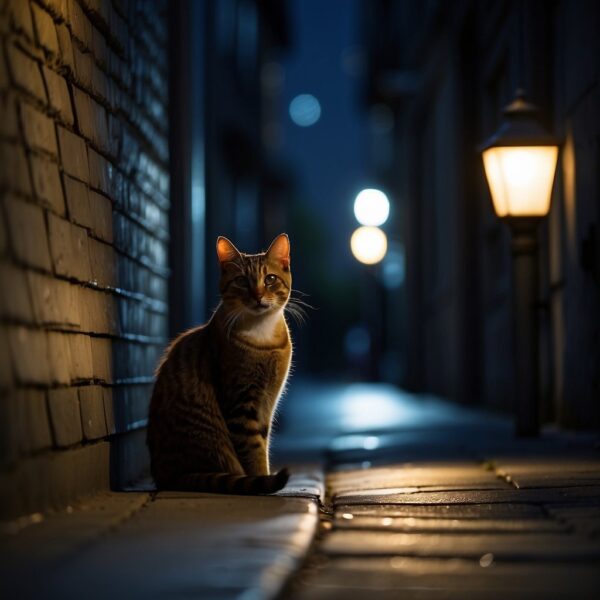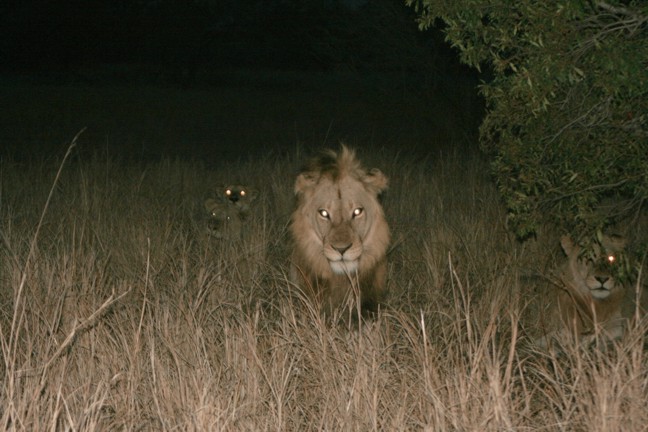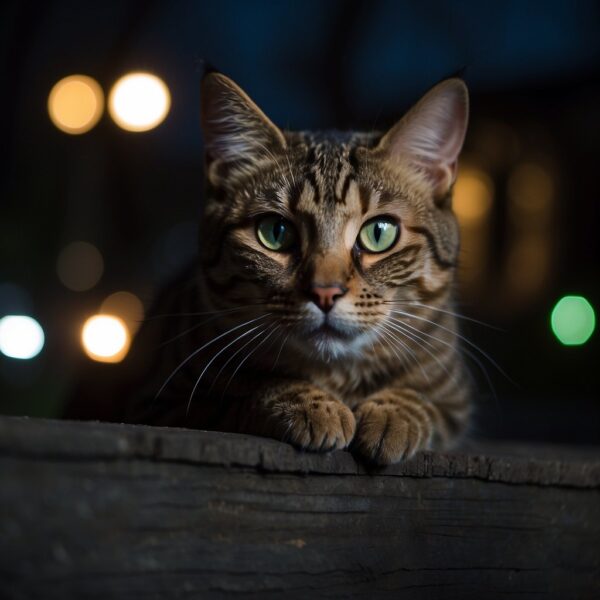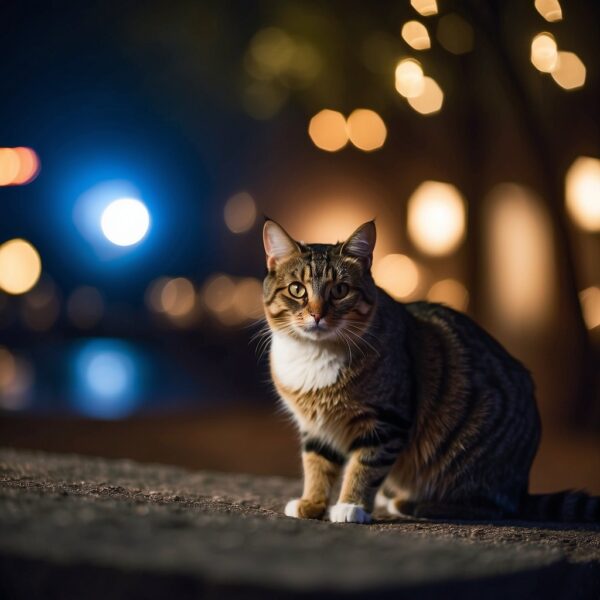
Understanding Cat Night Vision
Cats have long been subjects of curiosity and myth, especially when it comes to their sensory abilities. Their vision, particularly in low light conditions, is a topic of interest and common questions include whether cats can truly see in the dark. Cats possess certain adaptations in their eyes giving them a remarkable ability to see in lower light levels than humans. Among these adaptations are their large corneas and pupils, which can expand to let in more light, and a high number of rods in the retina which are sensitive to low light situations.
While cats cannot see in absolute darkness, their eyes are equipped with structures such as the tapetum lucidum, a reflective layer behind the retina that reflects light back through the retina, increasing the light available to the photoreceptors. This adaptation not only enhances cat night vision but is also responsible for the characteristic shine or glow of cats’ eyes when light hits them at night. Coupled with their crepuscular nature—being most active at dawn and dusk—cats have evolved as efficient hunters during times when light levels are low and prey is abundant.
Key Takeaways
- Cats have evolved to see well in low light but cannot see in complete darkness.
- The anatomy of a cat’s eye, including the tapetum lucidum, enhances their night vision.
- Cats’ peak activity times coincide with dawn and dusk, aligning with their visual adaptations.
Feline Vision Explained
Cats possess a unique set of visual adaptations that allow them to see in conditions of low light, giving them an evolutionary advantage when hunting at dawn and dusk.
The Anatomy of a Cat’s Eye
A cat’s eye has a large cornea and an elliptical pupil that expands and contracts to control the amount of light entering the eye. The lens works with the cornea to focus light onto the retina, an inner layer of the eye that contains photoreceptors known as rods and cones.
Photoreceptors: Rods and Cones
- Rods: These photoreceptors are abundant in a cat’s retina and are highly sensitive to light, making them crucial for low-light vision.
- Cones: While less numerous, cones facilitate daytime vision and allow perception of colors, albeit not as vividly as humans experience.
Can Cats See in the Dark? Low-Light Adaptations
Cats have a tapetum lucidum, a reflective layer behind the retina that reflects light that passes through the retina back into the eye. This increases the light available to photoreceptors and contributes to a cat’s ability to see in dim conditions.
Night Vision Versus Day Vision
- Night Vision: A cat requires only one-sixth of the light that humans do to see in the dark due to their high number of rods and the presence of the tapetum lucidum.
- Day Vision: During daylight, a cat’s vision is less sharp than a human’s because of the lower number of cone photoreceptors.
Peripheral and Central Vision
- Peripheral Vision: Cats have a broader field of view—about 200 degrees, compared to 180 degrees for humans—allowing them to detect movement over a wide area.
- Central Vision: Their central vision is not as detailed as human central vision, which can affect their ability to see fine details.
Comparison with Human Vision
- Light Sensitivity: Cats surpass human light sensitivity due to structural differences in their eyes, especially regarding the pupils and tapetum lucidum.
- Color Vision: Cats perceive colors differently and less vividly than humans since they possess fewer cone photoreceptors.
- Ultraviolet Light: Cats can detect some ultraviolet light, which is invisible to the human eye.

Crepuscular Behaviour and Hunting
Cats’ hunting efficiency is enhanced by their crepuscular nature, which aligns their periods of maximum activity with dawn and dusk, times when their prey is also active. Their specialized sensory abilities and night vision play critical roles in their hunting strategies.
Hunting at Dawn and Dusk
Cats are crepuscular creatures, meaning they are most active during the twilight hours of dawn and dusk. These periods offer dim lighting, which is advantageous for cats as hunters because many potential prey species are also active at these times. Crepuscular hunting aligns with the times when their vision is most effective and when they can best avoid detection by predators.
Vision and Hunting Strategies
The night vision of cats is a key factor in their capability to hunt in low-light conditions. A cat’s eyes have a high number of rod cells and a reflective layer behind the retina, called the tapetum lucidum, which enhances light sensitivity. This adaptation allows them to detect movement and shapes, vital for their ambush predator tactics. While their night vision is superior to that of humans, it is not perfect; details can be blurry, and distant objects may not be seen clearly.
The Role of Other Senses
In addition to their enhanced vision, cats rely heavily on their other senses to hunt:
- Hearing: Their ears can rotate to pinpoint the slightest of sounds, which can indicate the presence of prey.
- Whiskers and Paws: These are sensitive to vibrations and aid in detecting movement nearby.
- Sense of Smell: It is not as well-developed as in some other predators but still contributes to tracking prey.

Vision Development and Aging
Cats experience significant changes in their vision as they transition from kittens to senior cats. These changes can affect their ability to see in low-light conditions.
Kitten to Adult: Vision Maturation
When kittens are born, they are effectively blind and depend heavily on their mother for survival. However, their vision quickly develops within the first few weeks. By the time a kitten is approximately two months old, its eyesight begins to improve significantly, as it develops the ability to see in low-light conditions. This capacity for enhanced night vision continues to mature as the kitten grows, with visual acuity and color perception becoming more refined by the time they reach adulthood.
Elder Cats: Vision Deterioration
Aging in cats, like in humans, can lead to a decline in vision. Senior cats may experience vision loss or vision changes due to a number of age-related conditions. Cataracts, which can cause cloudiness in the lens, and retinal degeneration, both can significantly impair a cat’s ability to see, especially in the dark. Regular veterinary check-ups can help identify these issues early on, and in some cases, treatments may be available to help maintain an elder cat’s vision.
Cat Vision Compared to Other Animals
Cats exhibit a fascinating visual aptitude that is the product of both evolutionary adaptation and physiological specialization, making their vision distinct when compared to other animals.
Predatory Advantages
Cats can see in the dark and are equipped with superior low-light vision, which plays a critical role in their effectiveness as nocturnal predators. They possess a large number of rod receptors in their retinas, which greatly outnumbers those found in human eyes. This abundance of rods aids them in detecting movements and shapes in the dark, providing them with a marked advantage over their prey.
Sensory Comparisons
Animals have evolved a variety of sensory strengths that cater to their environmental needs.
- Cats: Their ability to see in the dark and sense of vision is keenly adapted for night hunting, while their sense of smell and hearing are also well-developed, complementing their optical abilities.
- Dogs: Commonly known for their acute sense of smell, they use this as their primary means of perception.
- Birds of Prey: These predators have excellent daytime vision for spotting prey from great distances.
- Bats: Rely more on echolocation than vision, demonstrating that not all predators depend primarily on sight.
Specialized Vision Traits
Cats’ eyes have certain anatomical features which are remarkably different from other species.
- Pupil Shape: Cats have vertical slit pupils that can open very wide to allow more light to enter, enabling cats to see in the dark, enhancing their night vision.
- Reflective Layer: A tapetum lucidum, a reflective layer behind the retina, acts to amplify light that enters the eye, further aiding in low-light conditions.
Ultraviolet Perception
Unlike humans, cats can perceive ultraviolet light. This ability may contribute to tracking prey as some rodents and other prey animals leave UV-reflective urine trails that are invisible to the human eye, but not to felines. The ocular media in cats’ eyes, which includes the lens and cornea, is designed to transmit UV wavelengths more effectively. This capability provides them with another layer of visual information and advantage in the wild.

Caring for Your Cat’s Vision
Cats rely on their vision for daily activities and interaction with their environment. Ensuring the optimum health of their eyes is a critical aspect of their overall well-being.
Common Vision Problems
Cats may suffer from various eye problems, including conjunctivitis, cataracts, glaucoma, and trauma-related issues. Symptoms like redness, discharge, or changes in eye appearance should not be ignored, as they may indicate the onset of such problems.
Monitoring and Maintaining Eye Health
Regular monitoring of a cat’s vision is essential for early detection of potential issues. Pet parents should observe their cat’s behavior for signs of visual difficulty, such as clumsiness or reluctance to jump onto higher surfaces. Daily checks for cloudiness or discharge can help maintain eye health.
When to Consult a Veterinarian
Should a cat owner notice symptoms like persistent squinting, noticeable eye irritation, or a significant change in eye color or size, it’s crucial to consult a veterinarian immediately. Timely medical intervention can prevent complications and preserve a cat’s vision.
Impact of Indoor Versus Outdoor Living
Indoor cats typically face fewer eye health risks due to controlled environments. In contrast, outdoor cats are more prone to eye injuries and diseases from foreign bodies or fights. A cat’s lifestyle can significantly influence their risk of developing vision problems.
Enhancing Visual Stimulation
Cats need an environment rich in visual stimuli to ensure proper mental and physical activity. Pet parents can provide activities that promote healthy eye movement and focus, from a variety of toys that encourage chasing and pouncing to perches with views of the outdoors.
Myths and Misperceptions about Cat Vision
The popular discourse on feline vision is rife with misconceptions, from the idea that cats live in a colorless world to the belief they navigate darkness as if it were daylight. Examining these myths not only corrects misunderstandings but also provides a clearer picture of how cats truly see the world.
Color Blindness Myth
It is a common misconception that cats are colorblind. In reality, cats have a type of color vision, but it’s not as vibrant or varied as human vision. They can perceive blues and yellows but may struggle to distinguish between reds and greens. This muted color perception should not be mistaken for an absence of color vision.
Nocturnal Versus Crepuscular
The belief that cats are nocturnal is partially misleading. While cats are often thought to have exceptional night vision that supports activity in total darkness, they are actually crepuscular, meaning they are most active during dawn and dusk. Their eyes are well-adapted to low-light conditions but not to complete darkness, a nuance that the nocturnal myth overlooks.
Superstitions Linked to Cat Vision
Superstitions have long linked cats to mystical abilities, potentially stemming from their reflective eyes and notable nighttime presence. However, the capabilities of cat vision do not include supernatural elements. Cats’ eye structure allows for enhanced light intake at night, but this physical trait should not be confused with myths that attribute magical qualities to their vision.

Frequently Asked Questions about cat night vision
Cats are often associated with their remarkable ability to navigate low light environments. This section addresses common inquires about the nocturnal capabilities of our feline companions.
At what age do kittens develop night vision?
Kittens are born with their eyes closed, but they begin to develop the ability to see well in low light as early as several weeks after birth, with their night vision typically becoming more refined over the next few months.
How do feline vision capabilities compare at night versus during the day?
Cats have superior night vision compared to their daytime sight because their eyes have a high number of rod receptors and a reflective layer behind the retina, enhancing their ability to see in low light. However, during the day, their vision is less sharp than a human’s due to fewer cone receptors.
Is it necessary to leave a light on for cats during the night?
Generally, it is not necessary to leave a light on for cats at night. Their eyes are well adapted to low light conditions, allowing them to see effectively during nighttime without the need for additional light sources.
Do cats have superior night vision compared to dogs?
Cats typically have better night vision than dogs due to larger corneas and pupils that allow more light to enter the eye, and the tapetum lucidum, which reflects light back through the retina, although some dog breeds with similar traits may also have enhanced night vision.
Are cats able to perceive colors, and how does that affect their night vision?
Cats can perceive some colors, though not as vividly as humans since they have fewer cone cells, which are responsible for color vision. This trade-off for fewer cones means more rods that aid in their night vision, allowing them to see better in low light conditions where color perception is less crucial.
How do cats react to complete darkness?
While cats excel in low light, they cannot see in absolute darkness. They rely on their other heightened senses like hearing and whisker sensitivity to navigate when the light is insufficient for their visual capabilities.